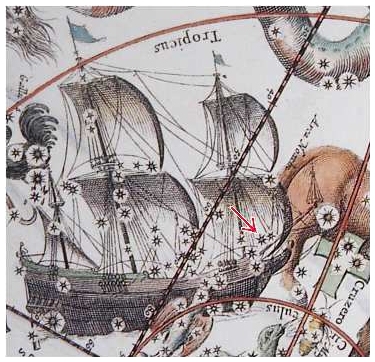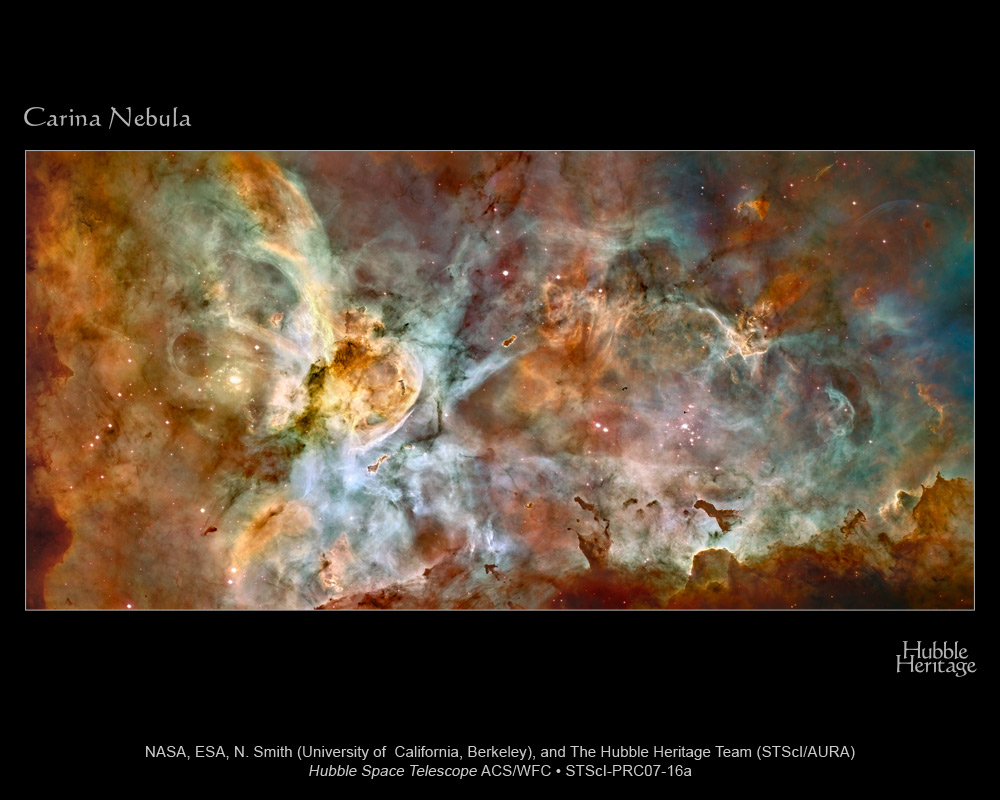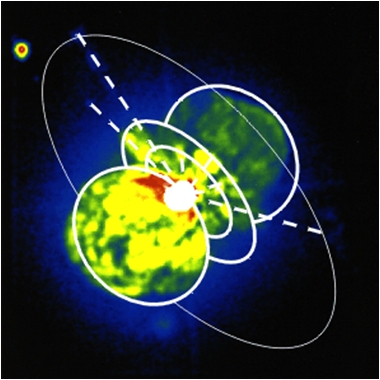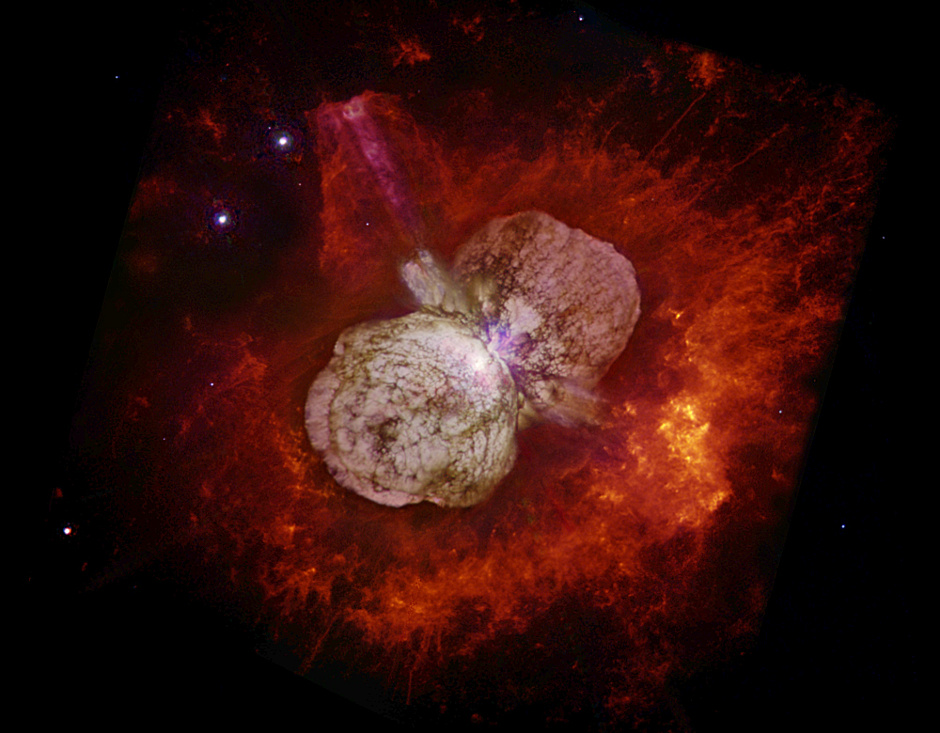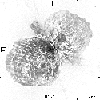Images of Eta Carinae and its vicinity
Argo Navis, with diminutive mizzen and quaint spritmast, sails a crowded southern sky around the year 1660.
Later constellation enthusiasts placed Eta Argus in the keel ("Carina", same root as "careen"); but in this old map by Andreas Cellarius, Eta is about to set fire to the foresail where we've marked it with an alarming red arrow.
This is a mirror image compared to modern star maps. That's Canopus under the captain's cabin, and the bright-looking star near the bowspirit is merely Delta Centauri.
The locale: The Great Carinae Nebula (NGC 3372) & The Keyhole Nebula (NGC 3324)
Eta Car is located in the Great Carina Nebula, NGC 3372, a famous star-formation region almost 2.3 kpc (7500 light years) away. The Keyhole Nebula (NGC 3324) is an expanding dark nebula within the Great Carinae Nebula just northwest of Eta Carinae. Eta Carinae is the most massive of a number of very massive young stars which ionize the gas in this region.
Finder Charts
Here are a few digrams that point out the main features of interest in the Great Carina Nebula.
- A diagram with scale indicated, plus some comments: Location of Eta in NGC 3372
- Locations of some other massive stars near Eta Car
Ground-based Optical Images
The enitire Great Carina Nebula is too large to image entirely with the HST, but you can find ground-based pictures at several observatories. All these are oriented with north at the top, east to the left (approximately). These two are from CTIO:
A Hubble Space Telescope Mosaic
An HST mosaic image of the Eta Carinae Nebula and the "Keyhole Nebula" within NGC 3372.
Ground-based Infrared Imaging
A near-infrared (2 micron) image of the region from the 2MASS survey is seen in Figure 1.
Figure 2 is a high resolution near infrared image that penetrates the dusty homonculus from Artigau et al. [].
Ground-based images of Eta itself
Here we really mean images of "the Homunculus", the notorious bipolar nebula ejected in Eta's Great Eruption about 160 years ago. Until the late 1980's, ground-based spatial resolution wasn't adequate to make the bipolar geometry obvious -- or rather, it didn't seem obvious until that time! The picure at left is a contour map made by Kris Davidson in the early 1980's
The Homunculus was first clearly recognized as a nebula 80 years ago. See the History Page
Today we can obtain much better ground-based images because techniques and telescope sites have improved, while Eta has grown brighter and the Homunculus has expanded. This object is considerably more spectacular today, seen through a moderate-size telescope, than it was 20 years ago. Few astronomers realize this, since large modern instruments generally don't allow non-electronic viewing.
The first ground-based image that clearly showed the Homunculus lobes was obtained by G. Weigelt's group in the mid-1980's, using a special multi-exposure technique at ESO. -- Or rather, the data were obtained then, but unfortunately not published until years later when the early HST images had already appeared. One version of that ESO image is shown here []
Hubble Space Telescope Images of the Homunculus
The first really successful color WFPC2 picture of Eta was produced in 1996 by Jon Morse using data obtained in Davidson's early HST programs. You can find it at various 'net sites including HST news '96. With its bipolar lobes plus equatorial debris, that image inspired a change of style for space explosions in Hollywood films of the late 1990's. We suspect it may even have influenced fireworks design.
* (For HST cognoscenti: The best WFPC2 filters for imaging the Homunculus have been F336W, F631N, and F1042W. So far as UV-to-near-IR images are concerned, this is mainly a dusty reflection or scattering nebula illuminated by the central star. Filter F631N, with a narrow bandpass intended for the [O I] spectral line, is the only visual- or red-wavelength choice that can avoid overexposure; fortunately there's practically no [O I] emission in the Homunculus so this filter samples the continuum fairly well, plus a little [S III] emission. Filters F656N (H-alpha) and F658N ([N II]) show faint outer ejecta -- mainly in [N II] emission -- but have serious deficiencies for quantitative applications.)
Grayscale image with a simple astrometric grid (799 x 799 GIF, 236 kB), perhaps showing small details better than the color versions. Here the grid spacing is 1 arcsec, coordinate orientation is J2000, and the central star's position is marked. To allow for expansion, note that most of the visible features were ejected from the star around 1843, the expansion velocities have been nearly constant since that time, and this WFPC(PC) image is dated 1995.75. It used filter F631N.
The Homunculus at non-optical wavelengths
- A famous AXAF/Chandra X-ray image shows thermal radiation produced by shocks: a hot central source and slower extended ejecta.
- Radio images (wavelengths ~ a few cm) can be found at White.

